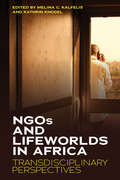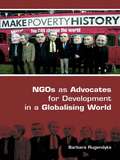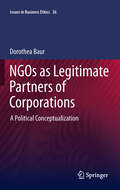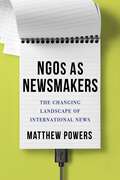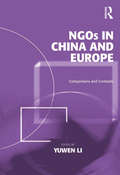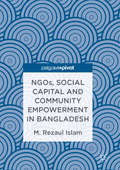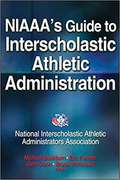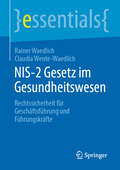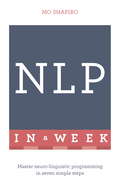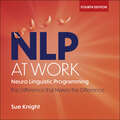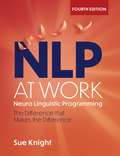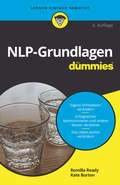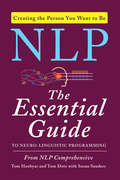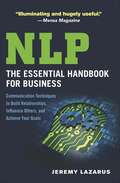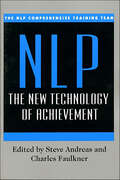- Table View
- List View
NGOs and Global Trade: Non-state voices in EU trade policymaking (Global Institutions)
by Erin HannahIn a deeply iniquitous world, where the gains from trade are distributed unevenly and where trade rules often militate against progressive social values, human health, and sustainable development, NGOs are widely touted as our best hope for redressing these conditions. As a critical voice of the poor and marginalized, many are engaged in a global struggle for democratic norms and social justice. Yet the potential for NGOs to bring about meaningful change is limited. This book examines whether improvements in participatory opportunities for progressive NGOs results in substantive and normative policy change in one of the major trading powers, the European Union. Hannah advances a constructivist account of the role of NGOs in the EU’s trade policymaking process. She argues that NGOs have been instrumental in providing education, raising awareness, and giving a voice to broader societal concerns about proposed trade deals, both when they take advantage of formal participatory opportunities and when they protest from the streets and in the media. However, the book also highlights how NGO inputs are mediated by the social structure of global trade governance. Epistemes—the background knowledge, ideological and normative beliefs, and shared assumptions about how the world works—determine who has a voice in global trade governance. Showing how NGOs succeed only when their advocacy conforms broadly to the dominant episteme, this book will be of value to scholars and students with an interest in NGOs and international trade negotiations. It will also be of interest to policymakers, national trade negotiators, government departments, and the trade policy community.
NGOs and Lifeworlds in Africa: Transdisciplinary Perspectives
by Melina C. Kalfelis Kathrin KnodelNon-governmental organizations (NGOs) have become ubiquitous in the development sector in Africa and attracting more academic attention. However, the fact that NGOs are an integral part of the everyday lives of men and women on the continent has been overlooked thus far. In Africa, NGOs are not remote, but familiar players, situated in the midst of cities and communities. By taking a radical empirical stance, this book studies NGOs as a vital part of the lifeworlds of Africans. Its contributions are immersed in the pasts, presents and futures of personal encounters, memories, decision-making and politics.
NGOs as Advocates for Development in a Globalising World
by Barbara RugendykeThis book traces the recent growth in NGO advocacy. Barbara Rugendyke presents empirical findings about the impacts of NGO advocacy activity on the policies and practices of global and regional institutions. The research reveals the mixed successes of advocacy as a strategy for addressing the ongoing causes of poverty in developing nations. Case studies illustrate the advocacy work of Australian NGOs, of British NGOs policies about engaging with multinationals, of Oxfam International’s advocacy directed at World Bank policies and NGO advocacy in the Mekong Region. Adopting an interdisciplinary approach, the mixed successes of advocacy as a strategy used by NGOs in attempting to address the ongoing causes of poverty in developing nations are examined. This volume is a useful aid to researchers, students and lecturers and to development practitioners interested in advocacy as a development strategy.
NGOs as Legitimate Partners of Corporations
by Dorothea BaurThe interaction between corporations and non-governmental organizations (NGOs) has become an important topic in the debate about corporate social responsibility (CSR). Yet, unlike the vast majority of academic work on this topic, this book explicitly focuses on clarifying the role of NGOs, not of corporations, in this context. Based on the notion of NGOs as political actors it argues that NGOs suffer from a multiple legitimacy deficit: they are representatives of civil society without being elected; the legitimacy of the claims they raise is often controversial; and there are often doubts regarding the legitimacy of the behaviour they exhibit in putting forward their claims. Set against an extended sphere of political action in the postnational constellation this book argues that the political model of deliberative democracy provides a meaningful conceptualization of NGOs as legitimate partners of corporations and it develops a conceptual framework that specifically allows distinguishing legitimate partner NGOs from two related actor types with whom they share certain characteristics but who differ with respect to their legitimacy. These related actor types are interest groups on the one hand and activists on the other hand. In conclusion it argues that a focus on the behaviour of NGOs is most meaningful for distinguishing them from interest groups and activists.
NGOs as Newsmakers: The Changing Landscape of International News (Reuters Institute Global Journalism Series)
by Matthew PowersAs traditional news outlets’ international coverage has waned, several prominent nongovernmental organizations have taken on a growing number of seemingly journalistic functions. Groups such as Amnesty International, Human Rights Watch, and Médecins Sans Frontières send reporters to gather information and provide analysis and assign photographers and videographers to boost the visibility of their work. Digital technologies and social media have increased the potential for NGOs to communicate directly with the public, bypassing traditional gatekeepers. But have these efforts changed and expanded traditional news practices and coverage—and are there consequences to blurring the lines between reporting and advocacy?In NGOs as Newsmakers, Matthew Powers analyzes the growing role NGOs play in shaping—and sometimes directly producing—international news. Drawing on interviews, observations, and content analysis, he charts the dramatic growth in NGO news-making efforts, examines whether these efforts increase the organizations' chances of garnering news coverage, and analyzes the effects of digital technologies on publicity strategies. Although the contemporary media environment offers NGOs greater opportunities to shape the news, Powers finds, it also subjects them to news-media norms. While advocacy groups can and do provide coverage of otherwise ignored places and topics, they are still dependent on traditional media and political elites and influenced by the expectations of donors, officials, journalists, and NGOs themselves. Through an unprecedented glimpse into NGOs’ newsmaking efforts, Powers portrays the possibilities and limits of NGOs as newsmakers amid the transformations of international news, with important implications for the intersections of journalism and advocacy.
NGOs in China and Europe: Comparisons and Contrasts
by Yuwen LiThis volume presents a comparison of the experiences of NGOs in China and Europe. The chapters on China contain the most comprehensive and up-to-date analysis of various types of NGOs currently active in the country. The contributions on foreign NGOs in China, non-governmental think tanks, public interest legal organizations, labour related NGOs and charity organizations, are the first in English to discuss successful experiences as well as the difficulties they face in the post-Mao era. The European studies draw examples from countries where the experiences of NGOs are at various stages of development. The section on NGOs in Central and Eastern Europe examines the rapid expansion of civil society and their pivotal role in promoting political change and building democracy in a transitional society, as well as the challenges they confront in advancing a strong civil society. Those chapters on NGOs' experiences in Western European countries, especially in the Netherlands and the UK, provide insightful information and examination of the most contentious issues concerning NGOs' accountability, governance and relationship with the government.
NGOs under Pressure in Partial Democracies
by Chris van der Borgh Carolijn TerwindtOver the past decade, international human rights organizations and think tanks have expressed a growing concern that the space of civil society organizations around the world is under pressure. This book examines the pressures experienced by NGOs in four partial democracies: Guatemala, Honduras, Indonesia and the Philippines. Based on fieldwork, it analyzes the complex processes of shrinking political space and the ways NGOs and grassroots organizations try to defend and reclaim their space.
NGOs, Political Protest, and Civil Society
by Carew BouldingThis book argues that non-governmental organizations (NGOs) have an important effect on political participation in the developing world. Contrary to popular belief, they promote moderate political participation through formal mechanisms such as voting only in democracies where institutions are working well. This is a radical departure from the bulk of the literature on civil society that sees NGOs and other associations as playing a role in strengthening democracy wherever they operate. Instead, Carew Boulding shows that where democratic institutions are weak, NGOs encourage much more contentious political participation, including demonstrations, riots, and protests. Except in extreme cases of poorly functioning democratic institutions, however, the political protest that results from NGO activity is not generally anti-system or incompatible with democracy again, as long as democracy is functioning above a minimal level. "
NGOs, Social Capital and Community Empowerment in Bangladesh
by M. Rezaul IslamThis pivot examines non-governmental organization (NGO) interventions in two community development initiatives, namely social capital and community empowerment, and their role in funding and formulating development frameworks in developing countries like Bangladesh. It considers the key development discourse issues of collective action, social trust and access to knowledge, to political processes and to financial, social and natural resources. Given the large proportion of foreign funding, NGOs and donors also increasingly face the twin challenges of demonstrating both efficient and effective delivery of services and accountability in their relationships with various stakeholders. Reflecting on the relevance of NGOs for community development, and the merits, challenges and limitations of NGO activities, this book provides a comprehensive study of NGO participation in community development in Bangladesh and Third World countries more widely to highlight a global concern with international implications.
NIAAA's Guide To Interscholastic Athletic Administration
by National Interscholastic Athletic Administrators AssociationNIAAA’s Guide to Interscholastic Athletic Administration presents a wealth of information and insights from experienced athletic directors across the United States. This comprehensive resource covers leadership, operations, financial and facilities management, and other chief administrative responsibilities to help readers better understand the athletic director’s multifaceted role. NIAAA’s Guide to Interscholastic Athletic Administration was developed under the direction of the National Interscholastic Athletic Administrators Association (NIAAA), the trusted authority for excellence in administration of high school sports. This guidebook features the best practices in high school athletic administration to assist both aspiring and practicing athletic directors in meeting the demands of the job. General guidelines and background knowledge are complemented by specific strategies and techniques. Each chapter offers examples of how to solve common problems, and sidebars highlight creative solutions employed by exemplary high school athletic directors. This text features guidance and multidisciplinary information on handling some of the toughest parts of the job. A chapter on personnel management discusses mentoring and evaluation systems to assist with the growth and development of staff, and a technology chapter offers specific recommendations of tools to help athletic directors operate more effectively and efficiently. A chapter on legal and safety concerns outlines concrete measures that administrators can take to prevent mishaps and protect their schools and staff from liability. Readers will also learn how to manage a budget and find creative alternatives to get the most out of available funds. Based on extensive research conducted by the editors, this text confronts several challenges facing contemporary high school sport administrators: • Providing comprehensive professional preparation for athletic director candidates and continuing education for today’s athletic directors • Aligning the goals of education-based athletic programs and the conduct of coaches, athletes, and parents engaged in the program to the educational mission of the school, district, state, and national governing organizations • Ensuring ongoing education in vital areas including student citizenship, staff support, safety, risk management, and budget preparation • Making consistent efforts to provide equitable opportunities for participation and accommodate the abilities and interests of all student-athletes The position of interscholastic athletic administrator is rapidly becoming one of the most challenging positions in any school as these professionals are asked to do more with less. Given proper education, tools, and goals, NIAAA recognizes the pivotal role an athletic administrator can have in enriching the school culture and experiences of participating athletes, parents, and coaches. NIAAA’s Guide to Interscholastic Athletic Administration provides fundamental knowledge guided by sound educational practices to enable athletic administrators to execute their daily duties with competence and confidence.
NIOS Book Code-319 Higher Secondary Course-Books 1 and 2 of Commerce -Business Studies
by National Institute Of Open SchoolingThis book covers the following important modules under Commerce for NIOS Senior Secondary Course: Business Around Us, Business Organizations, Business Management, Business Finance,Marketing etc.
NIS-2 Gesetz im Gesundheitswesen: Rechtssicherheit für Geschäftsführung und Führungskräfte (essentials)
by Rainer Waedlich Claudia Wente-WaedlichDie ausufernde Bürokratisierung überfordert Ärzte und Gesundheitsmanager in der ambulanten und stationären Versorgung durch immer höhere Verpflichtungen und Risiken. Die neue EU-Gesetzgebung mit dem NIS-2 Umsetzungsgesetz für konsequente Informationssicherheit und hohe persönliche Risiken für Führungskräfte stellt einen Paradigmenwechsel im Gesundheitswesen dar. Das Buch bietet Hilfe zur Selbsthilfe für alle, die Verantwortung in Krankenhäusern, Kliniken, Praxen sowie Pflegeeinrichtungen tragen. Ärzte können mit dem Wissen, das durch das Buch vermittelt wird, wieder ihre eigene Organisation beherrschen.
NKJV, Maxwell Leadership Bible, Third Edition, Ebook
by John C. MaxwellEvery believer is a person of influence. In the Maxwell Leadership Bible, leadership expert John C. Maxwell shows you the principles of leadership taught in God’s Word and how to use them. Whether you are an employee, a boss, a parent, or a neighbor, you are a person of influence in your part of the world. Throughout the pages of Scripture, John Maxwell has assembled the time-tested and irrefutable biblical principles of leadership to equip and encourage leaders with his signature approach, including the 21 Laws of Leadership, the 21 Qualities of a Leader, biographical profiles, and hundreds of notes.Features include:Now available in Thomas Nelson’s NKJV Comfort Print® typefaceOver 120 “Profiles in Leadership” lessons drawn from the people of the BibleHundreds of compelling short articles and notes on mentoring and influenceA complete reference index to the 21 Laws of Leadership and the 21 Qualities of a LeaderEasy-to-read 9-point print size
NLP In A Week: Master Neuro-Linguistic Programming In Seven Simple Steps
by Mo ShapiroNLP just got easier NLP in a Week provides a dynamic collection of tools, techniques and strategies that can facilitate excellence in all aspects of your life. This book will help you communicate more effectively and develop your interactions by studying: - the way you access and disseminate information through the language you use - your perceptions and the values you hold It will also offer you the opportunity to consider the different ways people filter information, thereby enabling you to create greater rapport by using their preferred filters and experiencing the world from their perspective. You will be able to increase your understanding of others by utilizing NLP's precision questions for clarification and thereby extending your 'map of the world'. NLP is based on the idea that mind, body and language interact to create our individual perception of what happens around us and that these perceptions, and their accompanying behaviours, can be changed. Developers of NLP believe that happiness and success are the result of specific patterns of thinking that can be learned by anyone. The psychiatrist R. D. Laing said: 'Change your body, change your mind. Change your mind, change your body.' When your mind is working with you and is on your side then your body will follow. You can use NLP to make changes whenever you feel stuck, and your new 'position' will enable new action. Your mind is your internal powerhouse that steers your thoughts and subsequent actions. The messages and thoughts from your mind have a significant influence on the way you feel and the actions you take. What is in your mind affects your health and wellbeing. What you think is what you get. NLP helps you increase the messages that are 'good' for you and diminish those that aren't. By the end of the week you will be able to use NLP at work and in your personal life in a way that will sharpen your skills and boost your achievements. - Sunday: What is NLP? - Monday: Identify empowering and limiting beliefs - Tuesday: Recognize how we re-present information to ourselves - Wednesday: Use precision questions to find out what people mean - Thursday: Identify different communication filters - Friday: Use the six levels of change and reframing - Saturday: Increase your options
NLP In A Week: Master Neuro-Linguistic Programming In Seven Simple Steps
by Mo ShapiroNLP In A Week is a simple and straightforward guide to neuro-linguistic programming, giving you everything you need to know in just seven short chapters. From communicating more effectively to creating greater rapport with others, you'll discover the ability to change what isn't working in your life and increase what is.This book introduces you to the main themes and ideas of NLP, giving you a basic knowledge and understanding of the key concepts, together with practical and thought-provoking exercises. Whether you choose to read it in a week or in a single sitting, NLP In A Week is your fastest route to success:- Sunday: What is neuro-linguistic programming?- Monday: Identify empowering and limiting beliefs- Tuesday: Recognize how we represent information to ourselves- Wednesday: Use precision questions to find out what people mean- Thursday: Identify different communication filters- Friday: Use the six levels of change and reframing- Saturday: Increase your optionsABOUT THE SERIESIn A Week books are for managers, leaders, and business executives who want to succeed at work. From negotiating and content marketing to finance and social media, the In A Week series covers the business topics that really matter and that will help you make a difference today. Written in straightforward English, each book is structured as a seven-day course so that with just a little work each day, you will quickly master the subject. In a fast-changing world, this series enables readers not just to get up to speed, but to get ahead.
NLP at Work, 4th Edition: The Difference that Makes the Difference
by Sue KnightThis major new edition of Sue Knight's bestselling book NLP at Work has been extensively revised and updated, with an emphasis on the heart of NLP - becoming a model of excellence. In addition to a new slant to every chapter, there are three new chapters on the key things that make the biggest difference for the greatest results: Humor: enabling you to stand back and see things from a different perspective Clean questions: minimising yourself to find out the essence of the other person Time: understanding how what you get in life is influenced by your relationship to time past, present and futureNLP at Work has sold over 100,000 copies and is one of the most popular books ever published on the practical skills of NLP and how it can be applied in business. It transformed NLP from a peripheral art into an accessible, practical concept with relevant applications in the areas of influence, communication, negotiation, teamwork and coaching. Clear, readable and jargon free, this book will help you get to the essence of what makes you and your business excellent and unique.
NLP at Work: 4th Edition: The Difference that Makes the Difference
by Sue Knight'This book may help you to understand life more clearly' Paul Smith, fashion designerWelcome to THE book on NLP. The essence of NLP is the ability to study and reproduce excellence in yourself and to support others to do the same. NLP AT WORK helps you do that by developing an attitude of curiosity, naivety and learning - and giving you the ability to improvise with skill in real-time. Neuro Linguistic Programming is how you make sense of your world and, most importantly, how you make it what you want it to be: * Neuro: the way you filter and process your experience through your senses. * Linguistic: the way you interpret your experience through language. * Programming: the way you make sense of your experience to create your personal programme. NLP AT WORK is one of the most popular books ever published on the practical skills of NLP and how it can be applied in business. It transformed NLP from a peripheral art into an accessible, practical concept with relevant applications in the areas of influence, communication, negotiation, teamwork and coaching. Clear, readable and jargon free, this book will help you get to the essence of what makes you and your business excellent and unique.(P) 2020 Hodder & Stoughton Ltd
NLP at Work: The Difference that Makes the Difference
by Sue Knight'This book may help you to understand life more clearly' Paul Smith, fashion designerWelcome to THE book on NLP. The essence of NLP is the ability to study and reproduce excellence in yourself and to support others to do the same. NLP AT WORK helps you do that by developing an attitude of curiosity, naivety and learning - and giving you the ability to improvise with skill in real-time. Neuro Linguistic Programming is how you make sense of your world and, most importantly, how you make it what you want it to be: * Neuro: the way you filter and process your experience through your senses. * Linguistic: the way you interpret your experience through language. * Programming: the way you make sense of your experience to create your personal programme. NLP AT WORK is one of the most popular books ever published on the practical skills of NLP and how it can be applied in business. It transformed NLP from a peripheral art into an accessible, practical concept with relevant applications in the areas of influence, communication, negotiation, teamwork and coaching. This major new edition has been revised throughout and expanded to include a new section on coaching with NLP, showing how this approach is so different to traditional methods, and a new chapter on Metamessages. Clear, readable and jargon free, this book will help you get to the essence of what makes you and your business excellent and unique.
NLP-Grundlagen für Dummies (Für Dummies)
by Kate Burton Romilla ReadySind für Sie die drei Buchstaben NLP ein Buch mit sieben Siegeln? Die NLP-Expertinnen Kate Burton und Romilla Ready erläutern Ihnen, was Neurolinguistisches Programmieren ist und erklären anhand anschaulicher Beispiele aus Ihrer Berufspraxis, welche Grundannahmen sich hinter den drei Buchstaben verbergen und wie Sie NLP wirkungsvoll für Ihre Zwecke einsetzen. Wenn Sie die NLP-Werkzeuge erst einmal verinnerlicht haben und sie gebrauchen, werden Sie die tägliche Kommunikation mit Ihren Kollegen, Freunden und Ihrer Familie rasch verbessern. Mit wenig Aufwand lernen Sie Ihre Ziele konsequenter zu verfolgen, Sprachmuster zu entziffern und Missverständnisse zu vermeiden. "NLP-Grundlagen für Dummies" ist Ihr Weg zu gelungener Kommunikation.
NLP: The Essential Guide to Neuro-Linguistic Programming
by Tom Hoobyar Tom Dotz Susan SandersNLP (Neuro-Linguistic Programming) has helped millions to overcome their fears, increase their confidence, and achieve greater success in their personal and professional lives and relationships. Now, from the company that created NLP: The New Technology of Achievement-one of the bestselling NLP books of all time-comes NLP: The Essential Guide to Neuro-Linguistic Programming. This user-friendly guide, written by three seasoned NLP Master Practitioners and coaches, leads you on a personal journey in using and applying NLP in everyday life. Through their real-life stories, you will experience the NLP strategies you need to achieve specific results in business and in life. As you read NLP: The Essential Guide, you'll find yourself thinking in new ways and applying the techniques to your own personal challenges and opportunities for greater satisfaction.
NLP: The Essential Handbook for Business
by Jeremy LazarusThe “illuminating and hugely useful’“ guide to using Neuro-Linguistic Programming techniques to build relationships, influence others, and achieve goals (Mensa Magazine).NLP: The Essential Handbook for Business is a straight-talking, highly practical guide to using NLP to significantly improve your results at work. Whether you want to be a better leader, manager, negotiator, salesperson, or decision-maker, you can learn proven NLP techniques that will boost your career as well as the performance of colleagues and the organization itself.Using real-life examples and easy-to-follow exercises that apply to individuals, teams, and organizations, NLP: The Essential Handbook for Business shows you how to:Improve communicationAchieve your career goalsDevelop your influencing skillsHarness the mindset for successGain a greater understanding of what motivates youRemove the limiting beliefs holding you back from the success you deserveWritten in accessible, jargon-free language, NLP: The Essential Handbook for Business contains numerous examples and practical exercises that will help you use NLP to improve your career and achieve success at work, whether in the private or public sector, and regardless of your current role.“Jeremy Lazarus has managed to demystify the central tenets [of NLP], penning a guide that is equally relevant to trainers and individuals and far more accessible than its rivals.” —People Management magazine
NLP: The New Technology of Achievement
by NLP Comprehensive Training TeamNLP has already helped millions of people overcome fears, increase confidence, enrich relationships, and achieve greater sucess. Now the NLP Comprehensive Training Team has written a book that reveals how to use this breakthrough technology to achieve whatever you want.Short for neuro-linguistic programming, NLP is a revolutionary approach to human communication and development. In NLP: The New Technology of Achievement, you'll be guided step-by-step through specific programs for learning the characeristics of top achievers and creating a blueprint for unlimited sucess. Plus, an all-new twenty-one-day program created especially for this book provides you with the essential skills you'll need to achieve peak performance in business and life.
NOW PT (A): Should We Invest?
by George A. Riedel Mel Martin Amy KlopfensteinIn fall 2021, a team of students from the HBS Impact Investing Fund considered Neurologic Optimal Wellness Physical Therapy (NOW PT) for a potential investment. Dr. Banks, the founder of NOW PT, drove to visit patients. She sought an investment from the fund to open a brick-and-mortar clinic. However, the students believed that Dr. Banks might be more successful if she continued providing mobile PT services. At the conclusion of the case, the students must perform due diligence to test their hypothesis. What should their priorities be as they begin the due diligence process?
NOW PT (B): Should We Invest?
by George A. Riedel Mel Martin Amy KlopfensteinThis (B) case examines the results of the HBS Impact Investment Fund student team's diligence on Neurologic Optimal Wellness Physical Therapy (NOW PT). After examining Springfield's demographics, anticipated PT demand, local competition, and NOW PT's financial statements, the students realized that NOW PT would be more successful if it opened a brick-and-mortar clinic. The case appendix provides the students' Investment Committee deck, which readers can reference as an example of a thorough due diligence process. The conclusion of the case reveals the students' investment recommendation and its results.
NOWaccount
by William A. Sahlman Ramana Nanda Lauren BarleyIt was September 2013, and NOWaccount Network Corporation (NOW ) co-founders John Hayes and Lara Hodgson were putting the final touches on the presentation deck for their annual shareholders' meeting. Along with co-founder Stacey Abrams, the pair had designed NOW's business model three years ago, and the company was at a critical juncture. NOW offered a program-called NOWaccount-that provided working capital to small businesses by converting their trade receivables almost immediately into cash. Founded in December 2010, Atlanta, Georgia-based NOW was serving clients in nine states. With 2013 year-to-date revenue of roughly $100,000, NOW was financed with $2.5 million of founder, and friends and family equity. NOW's wholly-owned, not-for-profit special purpose entity (SPE), Trade Credit Guaranty Corporation (TCGC), purchased approved receivables, funding 90% of the invoice face values by electronic transfers into clients' bank accounts. As of September 2013, TCGC had purchased more than $13 million of small business trade receivables from more than 40 clients. Once TCGC reached a scale of approximately $150 million of funds in use for receivable purchases, the co-founders planned to tap into the securitization market for capital by issuing asset-backed securities (ABS), collateralized by a pool of receivables, much like the credit card industry. ABS would provide TCGC ongoing capital at a lower cost. The question the co-founders confronted was whether they should get to the $150 million securitization threshold by piecing together smaller pools of capital from credit unions and possibly smaller banks (a slower approach but one that did not involve dilution because it was all debt finance), or by accepting larger chunks of capital from a major global bank and a private equity firm, getting them much closer to the threshold but at the cost of significant dilution (35%) as these financiers were also looking for a combination of equity and warrants in NOW.

